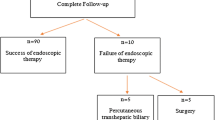Abstract
Background
Iatrogenic bile duct injury (BDI) is a common complication after cholecystectomy. Patients are mainly treated endoscopically, but the optimal treatment method has remained unclear.
Aims
The aim was to analyze endoscopic treatment in BDI after cholecystectomy and to explore endoscopic sphincterotomy (ES), with or without stenting, as the primary treatment for an Amsterdam type A bile leak.
Methods
All patients referred to Helsinki University Hospital endoscopy unit due to a suspected BDI between the years 2004 and 2014 were included in this retrospective study. To collect the data, all ERC reports were reviewed.
Results
Of the 99 BDI patients, 94 (95%) had bile leak of whom 11 had concomitant stricture. Ninety-three percent of all patients were treated endoscopically. Seventy-one patients had native papillae and a leak in the cystic duct or peripheral radicals. They were treated with ES (ES group, n = 50) or with sphincterotomy and stenting (EST group, n = 21). There was no difference between the closure time of the fistula (p = 0.179), in the time of discharge from hospital (p = 0.298), or in the primary healing rate between the ES group and the EST group (45/50 vs 19/21 patients, p = 0.951).
Conclusion
After the right patient selection, the success rate of endoscopic treatment can approach 100% for Amsterdam type A bile leak. ES is an effective and cost-effective single procedure with success rate similar to EST. It may be considered as a first-line therapy for the management of Amsterdam type A leaks.
Similar content being viewed by others
References
Nuzzo G, Giuliante F, Giovannini I, et al. Bile duct injury during laparoscopic cholecystectomy: results of an Italian national survey on 56591 cholecystectomies. Arch Surg. 2005;140:986–992. doi:10.1001/archsurg.140.10.986.
Veen EJ, Bik M, Janssen-Heijnen ML, De Jongh M, Roukema AJ. Outcome measurement in laparoscopic cholecystectomy by using a prospective complication registry: results of an audit. Int J Qual Health Care. 2008;20:144–151. doi:10.1093/intqhc/mzm073.
Karvonen J, Salminen P, Gronroos JM. Bile duct injuries during open and laparoscopic cholecystectomy in the laparoscopic era: alarming trends. Surg Endosc. 2011;25:2906–2910. doi:10.1007/s00464-011-1641-1.
Diamantis T, Tsigris C, Kiriakopoulos A, et al. Bile duct injuries associated with laparoscopic and open cholecystectomy: an 11-year experience in one institute. Surg Today. 2005;35:841–845. doi:10.1007/s00595-005-3038-z.
Barkun AN, Rezieg M, Mehta SN, et al. Postcholecystectomy biliary leaks in the laparoscopic era: risk factors, presentation, and management. Gastrointest Endosc. 1997;45:277–282. doi:10.1016/S0016-5107(97)70270-0.
Kaffes AJ, Hourigan L, De Luca N, Byth K, Williams SJ, Bourke MJ. Impact of endoscopic intervention in 100 patients with suspected postcholecystectomy bile leak. Gastrointest Endosc. 2005;61:269–275. doi:10.1016/S0016-5107(04)02468-X.
Bergman JJ, van den Brink GR, Rauws EA, et al. Treatment of bile duct lesions after laparoscopic cholecystectomy. Gut. 1996;38:141–147. doi:10.1136/gut.38.1.141.
Vitale GC, Tran TC, Davis BR, Vitale M, Vitale D, Larson G. Endoscopic management of postcholecystectomy bile duct strictures. J Am Coll Surg. 2008;206:918–923. doi:10.1016/j.jamcollsurg.2008.01.064. (discussion 924-5).
Mavrogiannis C, Liatsos C, Papanikolaou IS, Karagiannis S, Galanis P, Romanos A. Biliary stenting alone versus biliary stenting plus sphincterotomy for the treatment of post-laparoscopic cholecystectomy biliary leaks: a prospective randomized study. Eur J Gastroenterol Hepatol. 2006;18:405–409.
Karvonen J, Gullichsen R, Laine S, Salminen P, Gronroos JM. Bile duct injuries during laparoscopic cholecystectomy: primary and long-term results from a single institution. Surg Endosc. 2007;21:1069–1073. doi:10.1007/s00464-007-9316-7.
Baillie J. Endoscopic approach to the patient with bile duct injury. Gastrointest Endosc Clin N Am. 2013;23:461–472. doi:10.1016/j.giec.2013.01.002.
Aksoz K, Unsal B, Yoruk G, et al. Endoscopic sphincterotomy alone in the management of low-grade biliary leaks due to cholecystectomy. Dig Endosc. 2009;21:158–161. doi:10.1111/j.1443-1661.2009.00878.x.
Dolay K, Soylu A, Aygun E. The role of ERCP in the management of bile leakage: endoscopic sphincterotomy versus biliary stenting. J Laparoendosc Adv Surg Tech A. 2010;20:455–459. doi:10.1089/lap.2009.0308.
Sandha GS, Bourke MJ, Haber GB, Kortan PP. Endoscopic therapy for bile leak based on a new classification: results in 207 patients. Gastrointest Endosc. 2004;60:567–574. doi:10.1016/S0016-5107(04)01892-9.
Nordin A, Grönroos JM, Mäkisalo H. Treatment of biliary complications after laparoscopic cholecystectomy. Scand J Surg. 2011;100:42–48. doi:10.1177/145749691110000108.
Donatelli G, Vergeau BM, Derhy S, et al. Combined endoscopic and radiologic approach for complex bile duct injuries (with video). Gastrointest Endosc. 2014;79:855–864. doi:10.1016/j.gie.2013.12.034.
Fiocca F, Salvatori FM, Fanelli F, et al. Complete transection of the main bile duct: minimally invasive treatment with an endoscopic-radiologic rendezvous. Gastrointest Endosc. 2011;74:1393–1398. doi:10.1016/j.gie.2011.07.045.
Keulemans YC, Bergman JJ, de Wit LT, et al. Improvement in the management of bile duct injuries? J Am Coll Surg. 1998;187:246–254. doi:10.1016/S1072-7515(98)00155-0.
Sarr MG, Banks PA, Bollen TL, et al. The new revised classification of acute pancreatitis 2012. Surg Clin N Am. 2013;93:549–562. doi:10.1016/j.suc.2013.02.012.
Cotton PB, Garrow DA, Gallagher J, Romagnuolo J. Risk factors for complications after ERCP: a multivariate analysis of 11,497 procedures over 12 years. Gastrointest Endosc. 2009;70:80–88. doi:10.1016/j.gie.2008.10.039.
Rainio M, Lindstrom O, Udd M, Louhimo J, Kylanpaa L. Diclofenac does not reduce the risk of post-endoscopic retrograde cholangiopancreatography pancreatitis in low-risk units. J Gastrointest Surg. 2017;21:1270–1277. doi:10.1007/s11605-017-3412-3.
Marks JM, Ponsky JL, Shillingstad RB, Singh J. Biliary stenting is more effective than sphincterotomy in the resolution of biliary leaks. Surg Endosc. 1998;12:327–330.
Youngelman DF, Marks JM, Ponsky T, Ponsky JL. Comparison of bile duct pressures following sphincterotomy and endobiliary stenting in a canine model. Surg Endosc. 1997;11:126–128.
Funding
This study was supported by the Helsinki University Hospital Research Funds, Helsinki, Finland.
Author information
Authors and Affiliations
Contributions
MR collected clinical data and performed the data analysis and drafted the manuscript. OL and LK participated in designing and coordinating the study and provided supervision. CH collected clinical data. MU and AN provided supervision. All authors critically revised the manuscript and read and approved the final version.
Corresponding author
Ethics declarations
Conflict of interest
Mia Rainio, Outi Lindström, Marianne Udd, Carola Haapamäki, Arno Nordin, and Leena Kylänpää have no conflict of interest or financial ties to disclose.
Rights and permissions
About this article
Cite this article
Rainio, M., Lindström, O., Udd, M. et al. Endoscopic Therapy of Biliary Injury After Cholecystectomy. Dig Dis Sci 63, 474–480 (2018). https://doi.org/10.1007/s10620-017-4768-7
Received:
Accepted:
Published:
Issue Date:
DOI: https://doi.org/10.1007/s10620-017-4768-7




